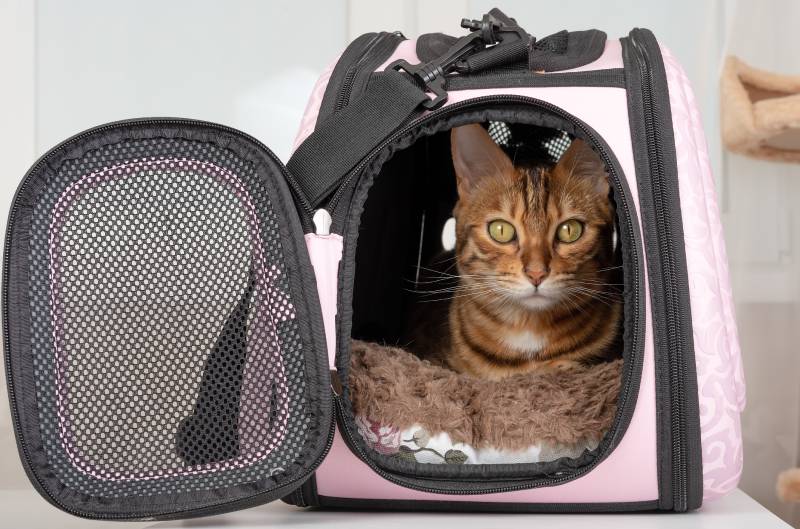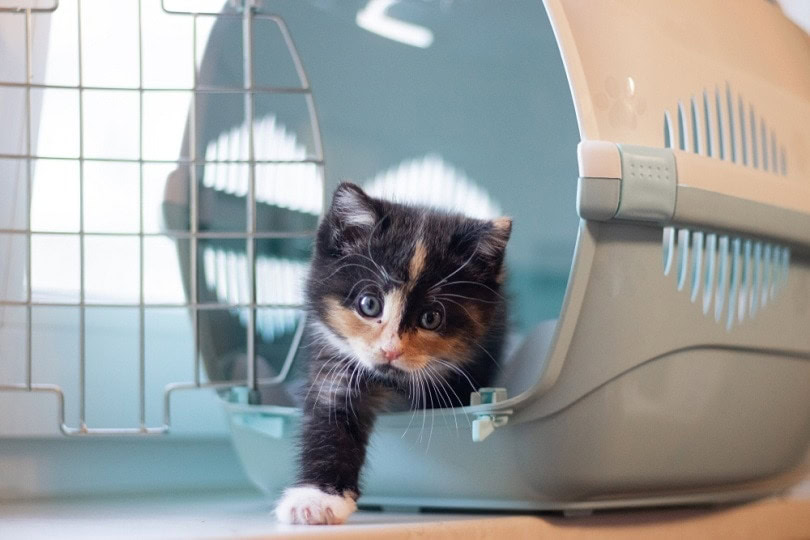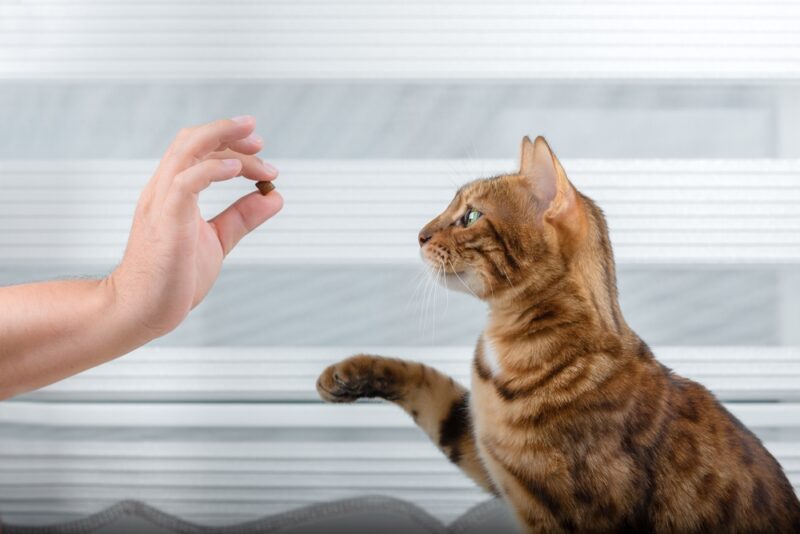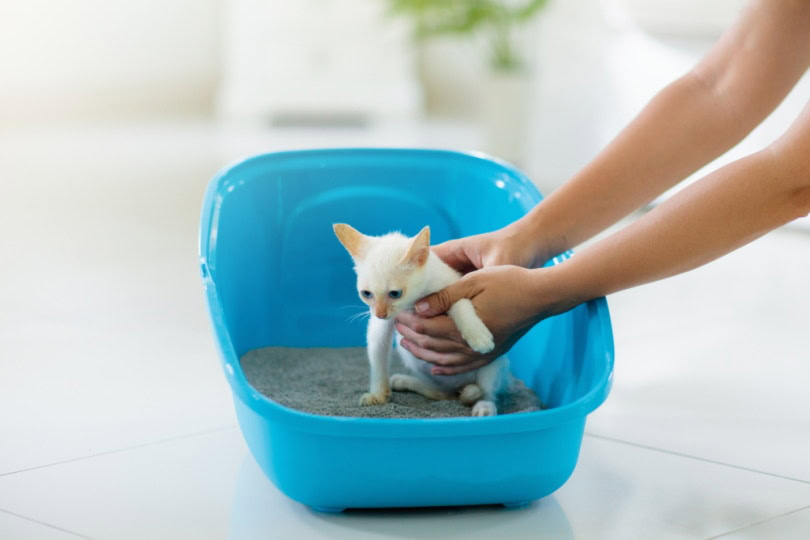VET APPROVED

The information is current and up-to-date in accordance with the latest veterinarian research.
Learn more »Cats are the second most popular pets in the U.S.,1 yet they see the vet far less often than the average dog. Since housecats don’t tend to get out that often, it can be difficult to get them accustomed to getting into a carrier.
As their owner, you are likely well-acquainted with just how stubborn your cat can be. When they don’t want to do something, convincing them to do it practically takes a miracle. This can translate into a tough time when it comes to getting your cat into their carrier, which you will need to do for visiting the vet, moving to a new home, or flying on a plane.
If you need a bit of help, read on, as we go over how to help your unwilling cat calm down and get into their carrier with less fuss and fewer scratches.

The 3 Tips on How to Get an Unwilling Cat Into a Carrier
1. Acclimate Them

If you don’t have time to get your cat accustomed to the carrier, see step 2 for tips on getting your cat into it without prior preparation. Be aware, though, that doing something like that to your cat can create exponential amounts of stress that can be damaging if they are already ill. It is always best to take the time and have the patience to try to acclimate them to their carrier before their next appointment.
Start by keeping your cat’s carrier out in a prominent spot in the home. Cats are intelligent creatures for the most part. If you only bring the carrier out when you need to, you will likely tip your cat off about what’s coming next. Instead, practice leaving it out for a while without doing anything negative with it.
One of the best methods for getting your cat acclimated to their carrier is to help them associate it with positive things. If you know that your cat has a veterinary appointment or you’re going on a trip when they will need to be in their carrier, use the following steps to get them ready.
- Two weeks before the trip, wash the carrier out, and ensure that it doesn’t have any smells that your cat might find offensive. These could include chemical smells from an incomplete rinse job or musty smells from being left in storage for too long.
- Set the carrier out so it is in plain sight of your cat, where they tend to go frequently. Leave the door to the carrier open and take the top off if possible, so they can explore it if they feel curious.
- Make the carrier inviting by putting in a blanket or a bed that smells like your cat and that represents things that they like and are comfortable with having with them.
- As the time gets closer, put your cat’s favorite treats into the carrier to lure them in whenever they are passing.
- Place the carrier next to their food and water bowl so they become more comfortable with it being around. Once they seem to feel comfortable with it, put the bowls inside the carrier. For a couple of days, feed them in the carrier.
If you follow this process without ever having to force them into the carrier, your cat will associate the carrier with positive things. This way, when the time comes, you shouldn’t have to do much to coax the cat inside.
2. Try the Purrito Technique

There is a chance that you might not convince your cat even after a couple of weeks of slow acclimation. If that is the case and you still need them to come with you on a trip or go to their vet appointment, you will need a different solution altogether.
The “purrito” technique is recommended for aggressive cats that don’t like being in their carriers. It enables you to protect yourself from your cat’s claws and keep them from getting so worked up that they end up hurting themselves while you try to put them inside their carrier.
- The purrito method involves wrapping up your cat so you can get them into the carrier. Start by taking the carrier out where they can’t see it, especially if they have learned to view it as a negative trigger. You can do this while they are sleeping or put it in a different part of the house.
- Prop the carrier so the door is open and faces the ceiling. Put it in an area where it won’t move, with the top of it backed against a wall or in an area like the back of a toilet. It is best to put the carrier in a room in which there aren’t many pieces of furniture for your cat to run under.
- Use a lightweight bath towel or a blanket that your cat likes. Make sure it is big enough to wrap your cat in and hold all their legs and paws yet thin enough to fit through the front of the carrier door when they are all folded up.
- Get your cat into the room with the carrier. Shut the door right away so they can’t run away from you.
- Gently and confidently, come up to your cat, and wrap them in the towel like they are the contents of a burrito, with only their head sticking out. You need the wrap to be tight enough over the top so they can’t escape. Just make sure you don’t cover their face so it allows them to breathe normally.
- Take your purrito tail-side down, and lower them into the carrier so they can’t see that you are putting them inside. As soon as they hit the bottom, shut the carrier door quickly. You don’t have to worry about unwrapping the towel. They will quickly unwrap themselves.
- Reward them once they are unwrapped with treats through the door so they will hopefully begin to associate the carrier with good things.
Even if the acclimation technique doesn’t work the first time, we suggest retrying it each time you need them to get into the carrier. The purrito method is best for those times when you need to quickly get an unwilling cat into a carrier and don’t have the time to get them accustomed to it. This technique is also useful, for instance, if you need to clip your cat’s claws or clean their ears.
3. Keep Your Cat Calm

Once the cat is in the carrier, you want to enact your plan of keeping them calm while they are inside the carrier. You don’t want them to end up hurting themselves by getting too anxious.
Tips to effectively keep your cat calm during the ride to the vet include:
- Spritz the towel that you use or put it in the carrier with a synthetic cat pheromone spray.
- Stay close to your cat and the carrier while they are inside. Leaving them trapped and alone can make them panic, even if it is just for a couple of minutes.
- Take practice car rides with your cat in the carrier without going to the vet, so they get used to it. Give them treats while in the carrier and once they come out.
If your cat has a deeply traumatizing memory involving a carrier, they might need more extreme methods to get them to remain calm. You might want to talk to a vet about a sedative to reduce their anxiety and make examinations easier.

Conclusion
Acclimating your cat with the tips given in step 1 is the best way to get an unwilling cat to use a carrier. If you don’t have enough time to do the entire process or it’s an emergency situation, the “purrito” technique in step 2 is your best bet. Regardless of why your cat needs to be in their carrier, do your best to keep them calm so it won’t end up being a traumatic experience for them. Be sure to talk to your vet for more advice on how to get your cat used to and even comfortable in their carrier, especially if they will need to take frequent trips in the future.
You May Also Want to Read:
Featured Image Credit: alenka2194, Shutterstock












